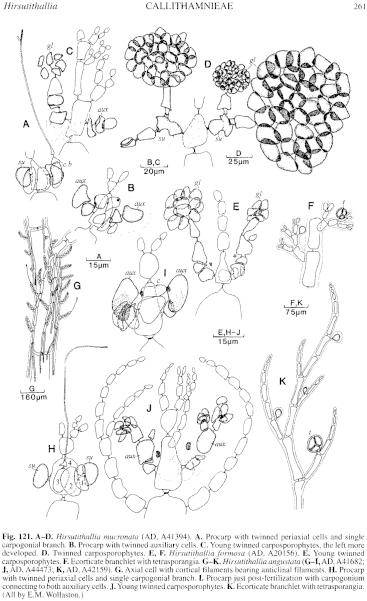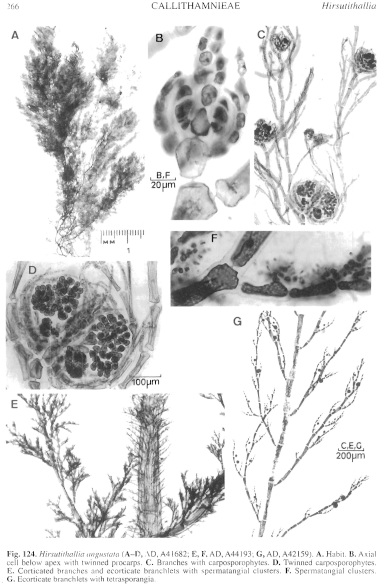|
|
|
|
|
|||||||||||
|
Electronic Flora of South Australia Species Fact Sheet
Phylum Rhodophyta – Order Ceramiales – Family Ceramiaceae – Tribe Callithamnieae
Synonyms
Callithamnion angustatum Hooker & Harvey 1847: 412. J. Agardh 1851: 64; 1876: 46. De Toni 1903: 1339. Harvey 1859b: 334; 1863, synop.: lii. Lucas 1909: 49. Sonder 1881: 10. Wilson 1892: 186.
Spongoclonium angustatum (Hooker & Harvey) De Toni 1903: 1361. Lucas 1909: 49; 1927: 467, pl. 34 fig. 1; 1929a: 24.
Thallus (Fig. 124A) medium to dark red, slender, 5–10 cm high, much branched openly and alternately radially, lightly corticate over lower branches. Holdfast small, 0.2–0.5 mm across, rhizoidal; apparently epilithic. Structure. Ecorticate laterals (Fig. 124B, D) and branchlets mostly 0.5–5 mm long, subdichotomous to laterally branched, basal and lower cells (35–) 40–75 µm in diameter and L/D (1.5–) 2–4, decreasing gradually over many cells to 15–25 µm in diameter, then to 3–5 short terminal cells 5–8 µm in diameter and L/D 1.5–2.5, often bearing a hair. Axial cells of corticate branches (Fig. 124E) increasing to 200–350 µm in diameter and L/D 2–5, lightly corticate in central and lower parts of the thallus with descending rhizoidal filaments from the basal cells of ecorticate branchlets; where lightly corticate (Fig. 121G) the rhizoidal filaments are laterally separated, but in lower parts cortication may be of several layers; outer anticlinal filaments are relatively sparse above, upwardly projecting, usually simple, some branched terminally, 4–8 (–10) cells and 100–300 µm long, but denser below. Cells uninucleate; rhodoplasts discoid to elongate, ribbon like in older cells.
Reproduction: Gametophytes dioecious. Procarps (Figs 121H, 124B) borne on axial cells 3–6 cells below branch apices which continue development, with a pair of opposite periaxial cells, one being the supporting cell of a 4-celled carpogonial branch. Post-fertilization the carpogonium enlarges transversely (Fig. 121I), with a nucleus in each end, but apparently does not divide. Auxiliary cells are cut off from the supporting cell and the other periaxial cell, and fusion occurs with each via small connecting cells. Each auxiliary cell produces a gonimoblast initial (Figs 121J, 124D) which produces successive rounded lobes of carposporangia, the terminal lobes developing first; mature carposporangia ovoid, 20–30 µm across. Mature carposporophytes (Fig. 124C, D) 200–350 µm across, surrounded by a lax involucre of 3–6 branched, curved, filaments from the axial cell(s) below the procarp, with the apical filament remaining above the fertile axial cell; the involucre is initiated very soon after fertilization. Spermatangia (Fig. 124E, F) on 1–3 laxly branched clusters (20–40 across) of ovoid cells on upper cells of ecorticate branchlets and on anticlinal filaments, usually one (occasionally 2) cluster per cell with a larger, isodiametric basal cell.
Tetrasporangia (Figs 121K, 124G) occur on cells of ecorticate branchlets and occasionally on the anticlinal outer cortical filaments, sessile, subspherical, 30–45 µm in diameter, tetrahedrally divided.
Type from Tasmania (prob. Georgetown) (Gunn); in BM.
Selected specimens: N Spencer Gulf, S. Aust., 8 m and 9 m deep (Shepherd, 6.ix.1973; AD, A44473 and 13.ix.1973; AD, A44193). Grange, S. Aust., 20 m deep on Chiracanthia on artificial reef (Branden, 5.x.1985; AD, A56807). Georgetown, Tas. (Harvey, Alg. Aust. Exsicc. 514; AD, A8272). Tinderbox, Tas., 6–11 m deep on shells (Kraft & Sanderson, 7.xii.1993; AD, A63944). Satellite I., D' Entrecasteaux Ch., Tas., 12 m deep (Shepherd, 17.ii.1972; AD, A41682). Great Taylor Bay, Bruny I., Tas., 19 in deep (Shepherd, 14.ii.1972; AD, A42159).
Distribution: N Spencer Gulf, S. Aust., to Port Phillip Heads, Vic. (Wilson) and N and SE Tasmania.
Taxonomic notes: H. angustata is the slenderest, most laxly branched species of Hirsutithallia, with typical cortication on the older branches and axes only. It differs from other species (except FL formosa) in having an involucre around the carposporophytes, and also in having more laxly branched spermatangial branchlets, attached by isodiametric cells.
References:
AGARDH, J.G. (1851). Species Genera et Ordines Algarum. Vol. 2, Part 1, I-XII, 1–336 + index. (Gleerup: Lund.)
AGARDH, J.G. (1876). Species Genera et Ordines Algarum. Vol. 3, Part 1- Epicrisis systematic Floridearum, pp. i-vii, 1–724. (Weigel: Leipzig.)
DE TONI, G.B. (1903). Sylloge Algarum omnium hucusque Cognitarum. Vol. 4. Florideae. Sect. 3, pp. 775–1521 + 1523–1525. (Padua.)
HARVEY, W.H. (1859b). Algae. In Hooker, J.D., The Botany of the Antarctic Voyage. III. Flora Tasmaniae. Vol. II, pp. 282–343, Plates 185–196. (Reeve: London.)
HARVEY, W.H. (1863). Phycologia Australica. Vol. 5, Plates 241–300, synop., pp. i-lxxiii. (Reeve: London.)
HOOKER, J.D. & HARVEY, W.H. (1847). Algae Tasmanicae. Lond. J. Bot. 6, 397–417.
LUCAS, A.H.S. (1909). Revised list of the Fucoideae and Florideae of Australia. Proc. Linn. Soc. N.S.W. 34, 9–60.
LUCAS, A.H.S. (1927). Notes on Australian marine algae. IV. The Australian species of the genus Spongoclonium. Proc. Linn. Soc. N.S.W. 52, 460–470, Plates 27–35.
LUCAS, A.H.S. (1929a). The marine algae of Tasmania. Pap. Proc. R. Soc. Tasm. 1928, 6–27.
SONDER, O.W. (1881). In Mueller, F., Fragmenta Phytographiae Australiae. Supplementum ad volumen undecinum: Algae Australianae hactenus cognitae, pp. 1–42, 105–107. (Melbourne.)
WILSON, J.B. (1892). Catalogue of algae collected at or near Port Phillip Heads and Western Port. Proc. R. Soc. Vict. 4, 157–190.
The Marine Benthic Flora of Southern Australia Part IIIC complete list of references.
Publication:
Womersley, H.B.S. (24 December, 1998)
The Marine Benthic Flora of Southern Australia
Rhodophyta. Part IIIC. Ceramiales – Ceramiaceae, Dasyaceae
©State Herbarium of South Australia, Government of South Australia
Illustrations in Womersley Part IIIA, 1998: FIGS 121 G–K, 124.

Figure 121 enlarge
Fig. 121. A–D. Hirsutithallia mucronata (AD, A41394). A. Procarp with twinned periaxial cells and single carpogonial branch. B. Procarp with twinned auxiliary cells. C. Young twinned carposporophytes, the left more developed. D. Twinned carposporophytes. E, F. Hirsutithallia formosa (AD, A20156). E. Young twinned carposporophytes. F. Ecorticate branchlet with tetrasporangia. G–K. Hirsutithallia angustata (G–I, AD, A41682; J, AD, A44473; K, AD, A42159). G. Axial cell with cortical filaments bearing anticlinal filaments. H. Procarp with twinned periaxial cells and single carpogonial branch. I. Procarp just post-fertilization with carpogonium connecting to both auxiliary cells. J. Young twinned carposporophytes. K. Ecorticate branchlet with tetrasporangia. (All by E.M. Wollaston.)

Figure 124 enlarge
Fig. 124. Hirsutithallia angustata (A–D, AD, A41682; E, F, AD, A44193; G, AD, A42159). A. Habit. B. Axial cell below apex with twinned procarps. C. Branches with carposporophytes. D. Twinned carposporophytes. E. Corticated branches and ecorticate branchlets with spermatangial clusters. F. Spermatangial clusters. G. Ecorticate branchlets with tetrasporangia.

|
Email Contact: State Herbarium of South Australia |

|